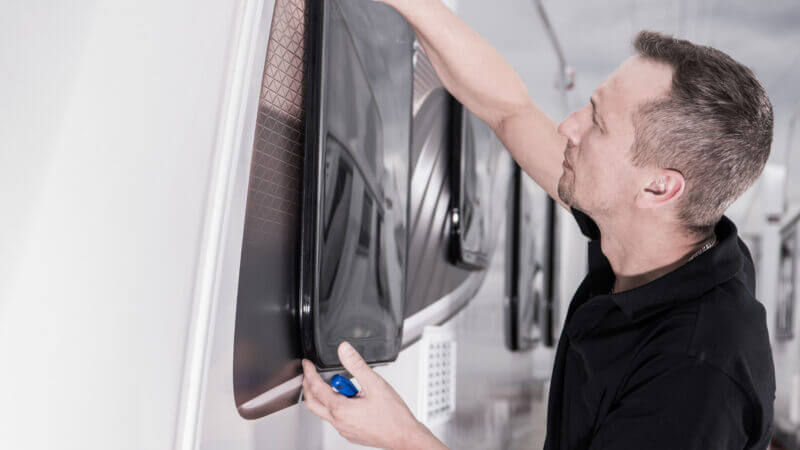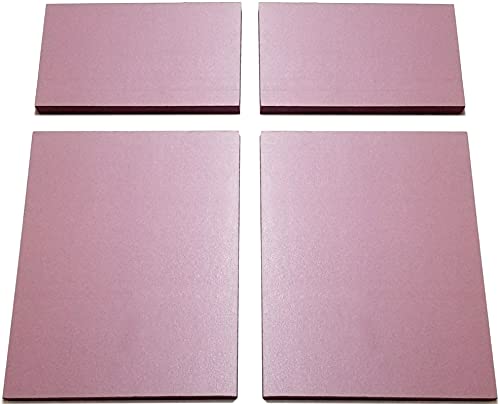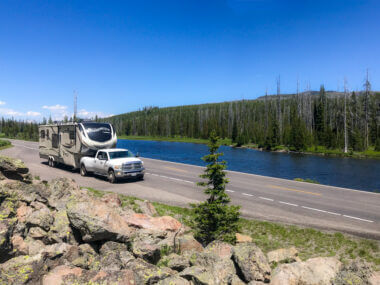Table of Contents Show
RV insulation is essential for having the best RV experience. Even RVs that claim to have a 4-season package may need insulation upgrades. Insulation not only helps you maintain a stable temperature in your RV, but it also prevents dreaded condensation issues!
But what kind of insulation is best for an RV? Keep reading to find out.
About RV Insulation
There are several types of RV insulation available. We’re going to cover each kind and when you may want to use it. But one of the bigger questions is, why do you need insulation in your RV?
Well, many RV manufacturers poorly insulate RVs. Even the 4-season RVs might end up being chilly when the temperatures drop. Condensation is another significant issue you’ll have when RVing, especially in cold weather. But it can be managed by properly insulating your RV.
Condensation occurs because your RV is warm and cozy, and the air outside is not. When your RV is poorly insulated, your windows, doors, and walls are cold. Sometimes your cupboards are also colder than the surrounding air as well, and if you have slides, this issue will be more pronounced.
There are naturally gaseous water particles in the air. When this gas comes into contact with a cold surface, it condenses and turns back into water. As a result, condensation occurs.
Think about a glass of ice water on a hot day. The air around the glass is hot (and filled with water particles in gas form). The glass is cold. Condensation is what causes the container to “sweat.”
In the RV scenario, any cold surfaces (windows, doors, walls) are like the glass described above. We don’t want our RV to “sweat” like the water glass. If left unchecked, condensation can cause long-term water damage. This one reason proper RV insulation is so important!
Another reason to invest in additional RV insulation is to regulate temperature better. You’ll save a lot of money by keeping your RV temperature regulated. This means maintaining heat outside in the summer and inside during the winter. Insulation can help with both scenarios.
We determine insulation efficiency using a number called an R-value. The higher the R-value, the more insulating.
Types of RV Insulation
Now let’s jump into the different RV insulation types and which one is best for your RV.
Fiberglass RV Insulation
Fiberglass insulation is what you would expect to see in a traditional home. It comes in big rolls and looks a lot like pink cotton candy. This type of insulation comes standard in many RVs tucked behind the walls.
Fiberglass insulation is beneficial and relatively low cost. But it’s not easy to install. After all, it goes behind your wall paneling. This means you’ll have to tear your RV apart, install it, and then put everything back as it was.
Fiberglass insulation also breaks down faster than other types. If you add moisture to the mix, the chance of mold buildup and insulation breakdown is even higher. So, if you travel to multiple or extreme climates, it may not be the best choice.
However, if you don’t mind a bit of a project and stay primarily in one climate, fiberglass RV insulation is a superb choice for its efficacy and cost.
Rigid Foam RV Insulation
Another fabulous way to insulate your RV is with rigid foam insulation. You can cut these long-lasting foam boards to size to fit in any space. You’ll also have flexibility in thickness. The thicker the foam, the more insulating it is. It’s also moisture resistant, making it a smart choice for traveling between climates.
Rigid foam insulation can be a challenge to install, and it’s more expensive than fiberglass insulation. However, if you’re traveling to extreme temperatures, it’s worth the hassle. It has a higher R-value, making it effective in all weather.
If you’re adding rigid foam insulation to areas that people don’t usually see, it’s elementary to install. For example, we installed rigid foam inside our RV’s cupboards and wardrobes to reduce condensation. It was easy to install, and since we didn’t mind how our cupboard interiors looked, we just installed it on top of the wall paneling.
Spray Foam RV Insulation
Spray foam RV insulation is another option if you’re replacing a small area or building from scratch. This type of insulation has a lower R-value, is challenging to install, and can be prohibitively expensive.
It can be messy if you overdo it because when you spray it, it expands. So, take it easy when you’re getting started and stick to the low expansion windows and doors version.
Spray foam insulation also provides an exceptional seal. That makes it perfect for insulating the nooks and crannies left by your RV manufacturer that might otherwise let in drafts. It isn’t the best option for extreme temperatures because of its lower R-value, though.
- Expands To Fill: Loctite Tite Foam Window & Door is a no bowing formula that fills, seals, and insulates effectively...
- High Density Foam: Offers high density with a uniform cell structure for durability and overall insulation for your...
Insulation for Windows and Doors
Insulating the windows and doors is the most critical part. Tons of heat (or cold air) escapes from these places. The good news is, insulating your windows and doors is a quick and easy DIY project.
One way to improve insulation is to re-caulk your windows and doors. If your RV is getting drafty, it’s probably a sign you need to do this. We also recommend replacing the caulk every two to three years for the most efficient temperature control.
You should also periodically replace your weatherstripping. As you open and close your doors, the weatherstripping will wear out. This also lets air sneak in or out of your RV.
There are also a few options for insulating your RV windows themselves. For example, if you have single-pane windows, they’re not efficient, and you should consider replacing them. They allow for air escape in the summer and the winter. Upgrading to double-pane windows will help keep your temperature controlled.
If windows aren’t in the budget, there are more cost-effective options. One is to put up Reflextix. This shiny, bubble-wrap-like insulation helps reflect heat from the sun in the summer and trap warmth inside in the winter.
The major downside is that you can’t see out your windows when the Reflextix is up. This might make you feel cooped up, especially in the winter!
- Reflective insulation for use in a crawl space, attic, wall, metal buildings and post and frame structures
- Fiber free, environmentally safe, easy to install and lightweight
If you’re someone who needs to have light in the winter, put up plastic film insulation. It’s easy to install, and it’s cheap. All you need to do is lay down double-sided tape around the windowsill. Then stick the plastic onto the tape. (Usually, everything you need comes in a kit you can buy at most hardware stores).
You’ll get a better seal if you heat the plastic with a heat gun. Plus, the plastic will shrink and be easier to see through. You can put it up and take it down as you move around or change temperatures. Best of all, you can still enjoy the views!
- This product adds a great value
- Product is highly durable and very easy to use
Tips for Staying Cool in the Summer
Staying cool in an RV is an enormous challenge, particularly when you’re traveling to Arizona, Texas, Florida, or other warm-weather climates in the summer. After all, you’re basically in a large metal box. Take any steps you can to keep the heat out.
If possible, always choose a parking spot in the shade. This simple tip will go a long way to keeping your RV cool. You can also cover windows and vents to keep the sun out. If you have external storage compartments, seal them up as well. Hot air can leak through drafty chambers.
One more tip we have for you is to skirt your RV. Usually, people think of skirting only for the winter, but it can also go a long way to keep your RV cooler in the summer. Skirting can be any type of material placed around the bottom of your RV to stop airflow.
Sometimes people use plywood, foam board, or a DIY tarp skirt. You can also buy professionally made skirts for a classier look. Professional skirting also works better in most cases. Skirting will stop hot air from moving under your RV and causing a warm draft.
Tips for Staying Warm in the Winter
Living in an RV is not for the faint of heart, especially in the winter. One essential way to stay warm in the winter is skirting. Skirting your RV in the winter prevents cold air from moving under your RV, keeping the underbelly warmer by trapping the heated air and preventing frigid air’s entrance.
You also need to insulate your windows and doors. Take our advice mentioned above, and your RV will be much less drafty and cozier in the chilly months.
You also can’t go wrong with tossing on another sweatshirt and curling up under a blanket with hot cocoa, of course.
What Type of RV Insulation is Right for You?
The best RV insulation depends on what you need and where you’re going. For stationary RVers or people who don’t travel to many climates, fiberglass insulation is ideal.
If you’re somewhere very humid, spray foam insulation might be best. It’s the most moisture resistant. Rigid foam insulation is optimal if you need something with a high R-value and lasts a long time. It’s more moisture-resistant than fiberglass. This makes it a splendid choice if you travel between several climates.
Installing RV insulation can be a process, but if you RV in any extreme weather (aka summer or winter), it’s worth it. Choose the best type of insulation, roll up your sleeves, and get to work. You’ll be glad you did!
Last update on 2024-07-26 / Affiliate links / Images from Amazon Product Advertising API











Havelock wool is really easy to work with and easily stuffs into crannies. Wicks moisture, cleans air, no mildew or mold. No smell and is relitively inexpensive.